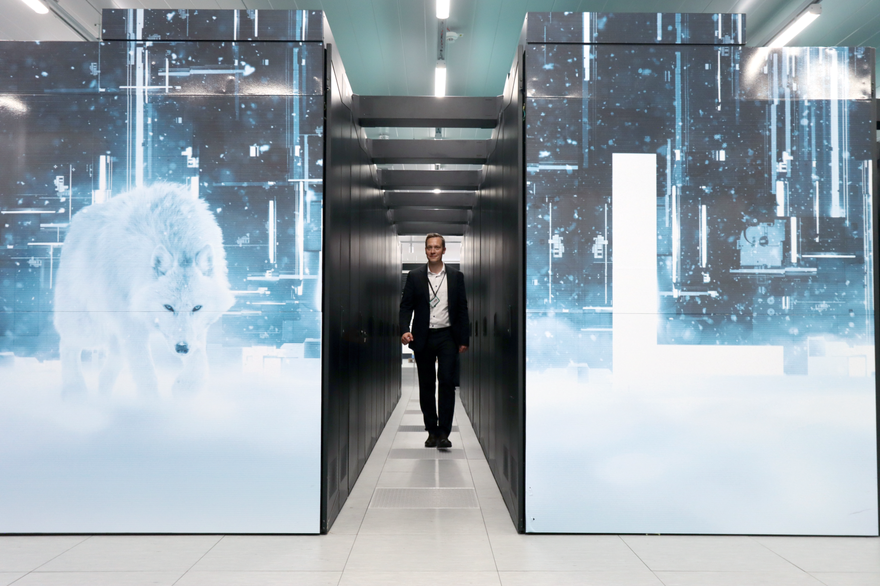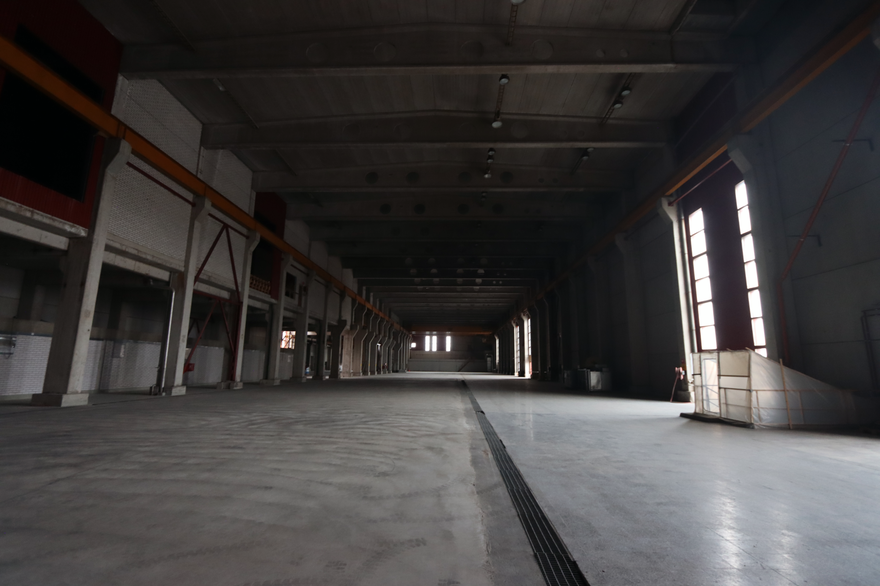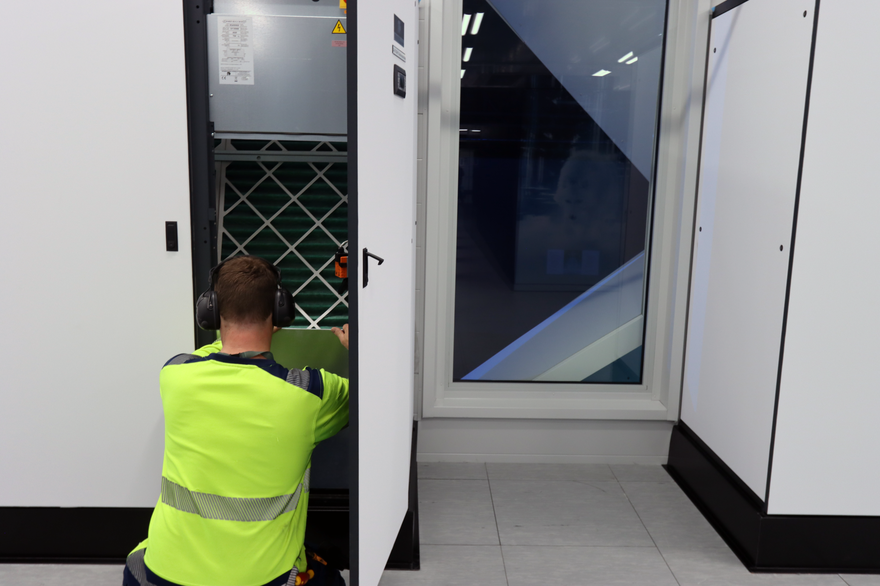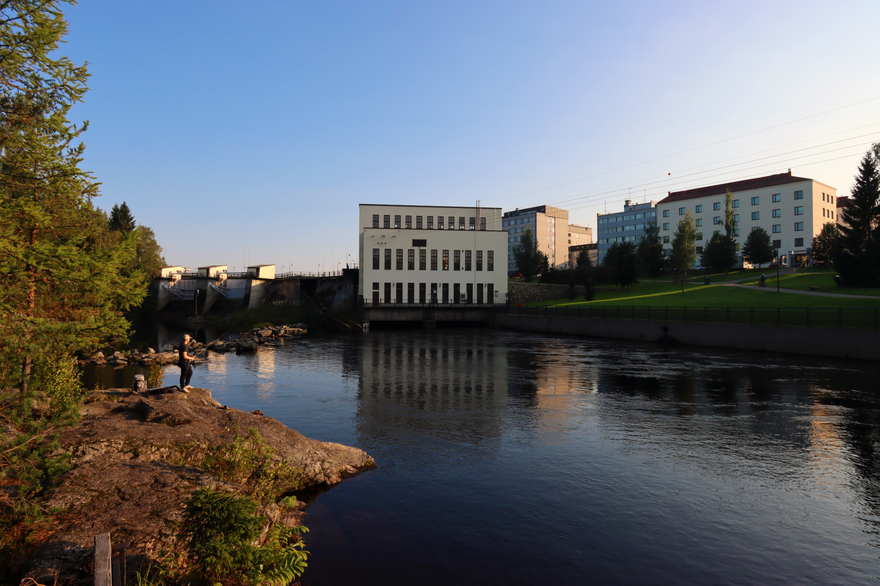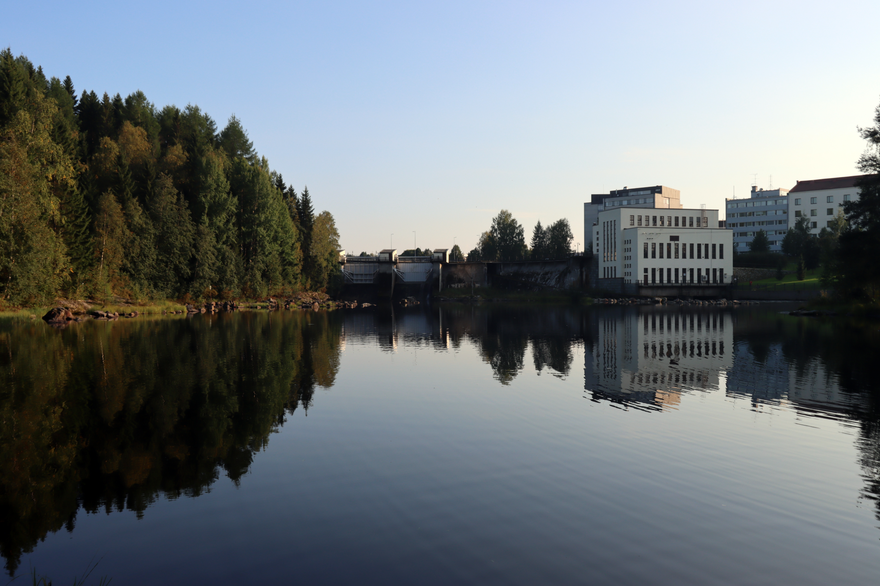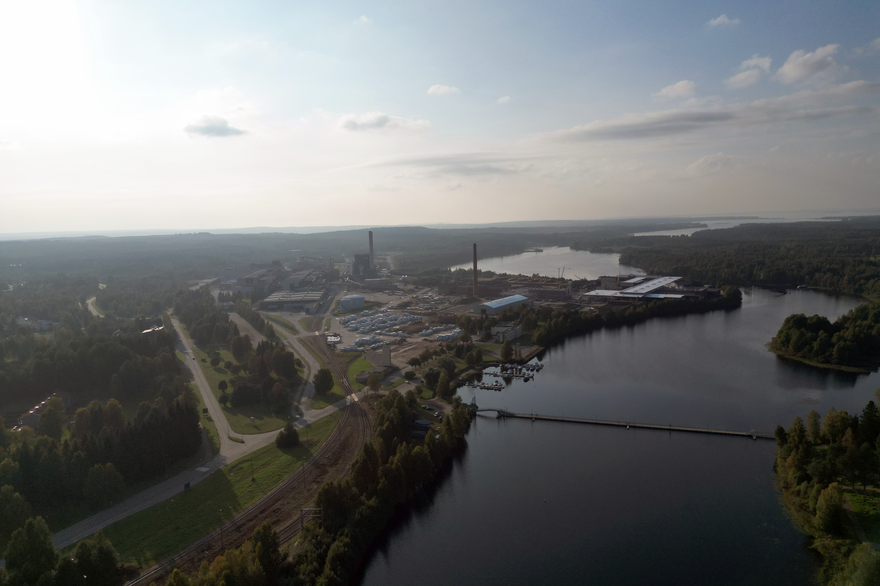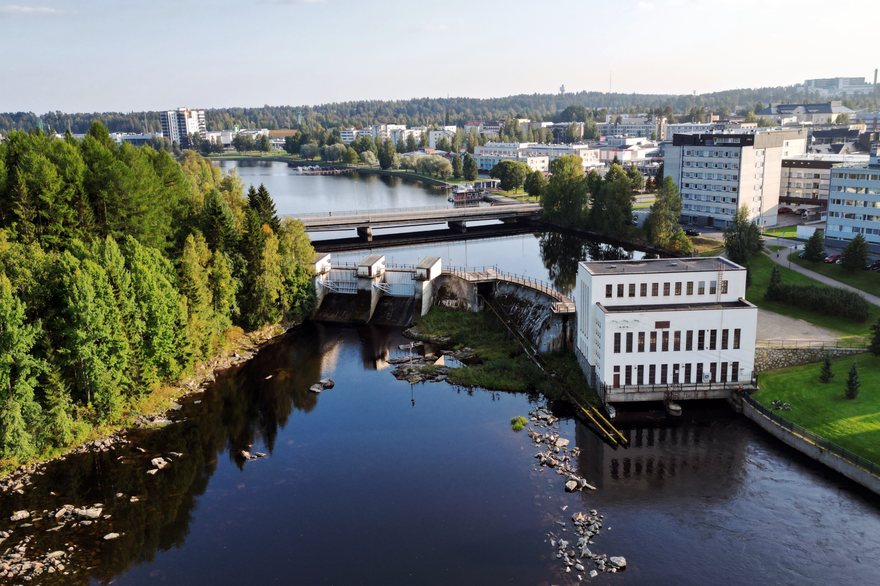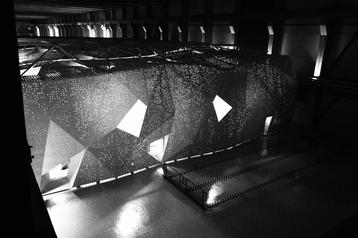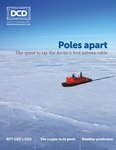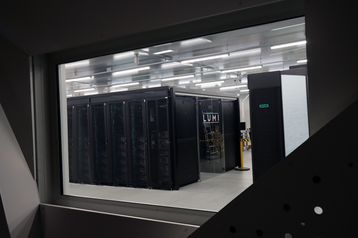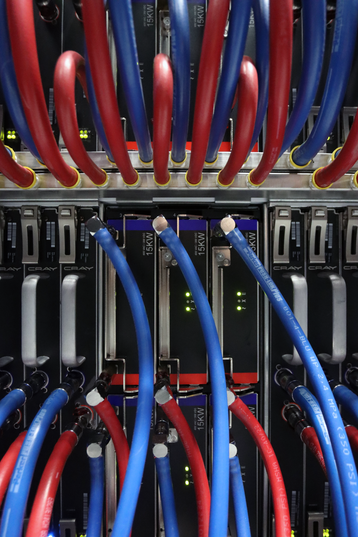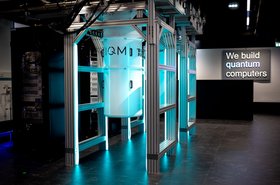Tucked away in a sleepy Finnish town, inside the giant hall of a disused paper mill, DCD comes across a vast glowing box.
We are in Kajaani, located in central Finland, to see Lumi, a 7.1MW European Union project set to help the Bloc as we enter the first innings of an era of artificial intelligence-assisted scientific research.
Now the world’s eighth most powerful supercomputer (it recently slipped out of the top five), Lumi was meant to look good. ‘The Queen of the North,’ as her operators call her, is a building within a building.
This feature appeared in Issue 55 of the DCD Magazine. Read it for free today.
The cavernous hall of the former United Paper Mills site is so large that it acts merely as a first layer protective shell around the data center itself, built to comparatively modest proportions, at 300 sqm (3,230 sq ft).
An HPE Cray EX235a system supercomputer, it features 2,978 AMD Epyc Trento CPUs, 11,912 AMD MI250X GPUs, and another 2,048 dual-socket AMD CPUs in a separate partition. Altogether, it has a sustained performance of 379.7 petaflops (HPL).
Its facade is intentionally irregular, with straight walls replaced by odd angles. The face is pocked by slits, from which a glittering light emerges. Unlike the usual grey data center, this one appears closer to a futuristic Christmas bauble.
“The aluminum coating and look was a relatively trivial question in the budget, and we pushed the product manager and the architects to come out with something that looked special,” Dr. Pekka Manninen, director of science and technology at Lumi, says.
“Just for the stakeholder work and political goodwill, I think it’s paid off.”
In an age of ever-present economic and political crises, where science is often lambasted as a luxury boondoggle, Dr. Manninen and the other workers at Lumi are keen to repeatedly tout the broader virtue of supercomputers. Lumi has been good for locals, for the EU, and for humanity more broadly, they say.
The collapse of the UPM mill, once the town’s largest employer, was not the economic death knell it could have been for Kajaani. UPM spent millions on supporting laid-off staffers and converting the site into a business park following the closure in 2008, while the Finnish government pumped in tens of millions more.
Around the same time, the increasing price of Finnish wood fiber and decreasing demand for paper had claimed another victim – Stora Enso’s Summa Mill in Hamina, to the south.
That site was picked up by Google in 2009, which converted it into a unique data center cooled by seawater. In May 2024, Google announced a €1bn ($1.055bn) expansion to the site, bringing its total investment in Finland to more than €4.5bn ($4.75bn).
That deal gave Dr. Manninen and Finland’s IT Center for Science (CSC) an idea: To search for their own disused paper mill. CSC was operating out of Keilaniemi, near Helsinki, at the time. “It’s the most expensive square meter price for space in the country, and then it turned out that we wouldn’t be able to bring more than 1MW online,” Dr. Manninen says. “We saw what Google did and looked at three different mills before we ended up in here.”
Kajaani benefits from low but not extremely low ambient temperatures and has a series of hydroelectric power plants that were built to support the mill, with some 235MW available.
CSC soon shifted Finland’s national supercomputers to a site on the Renforsin Ranta business park in the town, with the government again providing additional funding to support Kajaani. SGI, Cray, and even Russia’s T-Platforms all provided supercomputers for the agency over the years.
It is currently home to Finland’s national supercomputers Mahti and Puhti, which are set to be replaced by the 49 petaflops Roihu.
The wider park is also home to a Borealis data center, more government systems, and soon a system from British high-frequency trader XTX Markets. In a nice quirk of history, Google itself this November bought land in Kajaani (albeit not at the mill) for a potential data center – citing the growing data center community as its rationale.
Lumi came in 2021 as a joint project with the EU. “We were running procurement negotiations during Covid-19, and then started the installation in June 2021, beginning with the heavy processors and the storage systems,” Dr. Manninen recalls.
“We then started on the second phase, the GPU deployment. But we were hit by another black swan event – a global shortage of electronics. It was suddenly impossible to get some small components – power controllers, FPGAs, etc. We were held up by $1 chips.”
Still, the team brought the system fully online, with its GPU partition, in the summer of 2022, just before ChatGPT launched and changed everything.
“When Lumi was designed, the generative AI [era] was not foreseeable, but we knew that deep learning would be huge,” Dr. Aleksi Kallio, the manager for CSC’s AI development program, tells DCD.
A colleague of his worked at the education ministry that CSC reports to when the chatbot first debuted. “They have these regular meetings, and at the previous meeting, they decided that we are not so interested in this AI topic anymore, because it’s maybe going away,” he said. “And then ChatGPT came out: The next meeting, we decided that we were once again very interested in the topic.”
Lumi has been used by the University of Turku to develop Finnish and Nordic-language-specific large language models (LLMs). These languages have so far been ignored by those AI system developers with commercial concerns. Beyond its impact in helping maintain a language for the potential next step of computing, it also benefits AI more broadly, Katja Mankinen says.
“There is not that much Finnish in the Internet to use,” says Mankinen, CSC’s senior data scientist. “The data is quite limited, but they combined Finnish resources with larger resources such as English, and they developed some quite nice tricks on how to make high-performing Finnish models without compromising their quality. So this is one of the things that we believe will lay the base for the future around writing AI applications.”
Dr. Kallio adds: “Commercial players don’t do things openly. They don’t tell what kind of data is given by the models. They don’t talk about the model architecture. There are so many hidden things, but these models, they are public for everyone to use and everyone to learn from, for other researchers to build on top of the models.”
It is but one project on the supercomputer, Mankinen says: “In Lumi, you can build everything from the really smallest scales – from simulating the matter of particles, how they interact, what the properties are, to what happens in the universe at the galactic scale. Then we also have projects that help more like societal issues, how to cure cancer, how to create personalized medicine, how to help people who have health problems, etc.”
Lumi operates like other supercomputers under the European High-Performance Computing Joint Undertaking (EuroHPC JU) umbrella – member states and project funders get a portion of the system, while the hosting country that paid more gets to use more.
Finland offers a section of its component to businesses – but access is only free if they open source the results, otherwise they have to pay. Their work is still expected to be broadly in the public interest. Military workloads are banned.
Another workload is Destination Earth (DE), an ambitious EU project to simulate the entire planet, first exclusively covered by DCD in 2020 (see Issue #37).
“This is a European Commission project to develop an information system to support decision-making so they can make policy based on scientific facts,” Dr. Mankinen says. “Can we do something about the global climate, how can we adapt, what will happen with food, wildfires, precipitation, etc? These are societal questions.”
Unlike any other project, it has a dedicated section in the data center for storing data, consisting of around 100PB of capacity. It does not currently have dedicated compute, competing for time along with everyone else, but that could change in the future as the project grows in scope.
There is no upper limit to the demands of simulating the Earth, Dr. Mankinen notes, when asked how large a Destination Earth supercomputer could be.
DE also represents a potential inflection point in the development of supercomputers.
Historically, high-performance computing has focused on high-precision floating point 64 simulations, but AI has pushed for ever lower floating points, potentially going as low as FP4. “GPU vendors seem to focus a lot on AI flops,” Dr. Mankinen says.
“Traditional FP64 workloads are not necessarily any faster on the upcoming generation of GPU than they are currently, maybe they are even slower.
“You are probably going to see bifurcation in supercomputers, where some will be more like AI systems and some more like HPC systems.”
Dr. Kallio is hopeful this does not come to pass: “We really don’t know the future of AI and the safest way to build for it is to have some general purpose capacity well connected together. I think and hope that it will not go down different paths, but we can stay on one single path with one technology.
“Of course, it might mean that we are going to have some accelerators and special purpose hardware connected through the general purpose GPU cluster.”
Looking to projects like DE, he says that “what we see as extremely important in the future is the fusion of AI and HPC methods in science. Usually, you start with simulating through the HPC side, then you have an AI model built on that data.”
All of this brings the Lumi workers – who are planning to deploy a larger EU AI system in the years to come – back to their core argument: The supercomputer has been a boon for society.
On the local scale, the system is also providing benefits, albeit not in jobs – “one fallacy is that you need to put your data center where your staff is,” Dr. Kallio says. “Our staff are not here; they are in Helsinki. We are a skeleton crew in Kajaani.”
Lumi produces 40°C (104°F) waste heat water, which CSC then bumps up to 80°C (176°F) with heat pumps to send to the existing district heating network. The heating system “burns pretty much everything it can burn, including food and oil,” Dr. Mankinen explains. “So that’s why we call Lumi carbon-negative, because they can reduce the amount they are burning.
“During the summertime, basically all the heating needs of Kajaani are from us, but in the winter they still need to burn.”
CSC is also using the supercomputer’s uninterruptible power supply (UPS) to run a pilot scheme for grid frequency regulation, but Dr. Mankinen admits that they only deployed UPS systems to meet the procurement requirements.
When it was a paper mill, the site experienced only a single two-minute power outage during its 38 years of operations, thanks to the stable, nearby hydropower.
A future exascale supercomputer may cut the UPS entirely, he posits, as he lays out a vision for a number of ever larger systems in Kajaani.
“Supercomputing has a big footprint,” Dr. Mankinen says, both in power and cost. “We can and must use supercomputers to improve the quality of our future.”
Read the orginal article: https://www.datacenterdynamics.com/en/analysis/lumi-europes-fastest-ai-supercomputer-finland/


